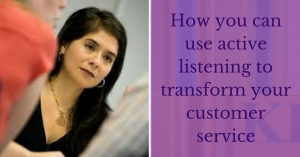 We all know how horrendous bad service can be. I’ve yet to meet anyone who hasn’t been ignored by a shop assistant or kept waiting in a restaurant. Sometimes we can leave disappointed because we haven’t been listened to.
We all know how horrendous bad service can be. I’ve yet to meet anyone who hasn’t been ignored by a shop assistant or kept waiting in a restaurant. Sometimes we can leave disappointed because we haven’t been listened to.
I’ll give you an example: one of my relatives can’t eat anything with dairy in it. Her favourite restaurants will not only explain which choices are dairy free but also which can be adapted for her. A lot of chains are now catching on and have alternative menus for common allergies. However, last year she went for a meal at a local pub. She explained the situation to the lovely waitress and then watched as she spoke to the surly looking manager. The manager grunted “just give her that” and thrust a menu towards her. It was the gluten free menu. The pub’s loss was the fish and chip shop’s gain.
Taking good service to the next level
Sometimes good listening is easy. Your customer explains what they need and you provide it. Occasionally they ask for something novel and you have to work a little harder to deliver a solution.
However, if you want to transform good service into great service, you could try active listening.
What’s active listening?
Active listening was first used in counselling and conflict resolution but its use has become more widespread. You might have seen the photographs of Prince William crouching down to talk to his son – a perfect example of active listening.
Essentially, active listening goes beyond normal conversation. You’re trying to gain a deep understanding of what the other person means by engaging on their terms. You interpret not only their speech but also their body language. Often, we get frustrated because we can see someone’s listening but we feel we’re at cross purposes. Active listening tries to avoid this.
How do I do it?
If you want to use active listening with your customers you need to focus not only on what they say but how they say it. Say you’re dealing with a complaint. You may be lucky and have a customer who comes and tells you exactly what the problem is and how you can resolve it. If you’re really fortunate the solution will be something you can deliver! Occasionally you might have to work through a range of smaller niggles to find out what’s bothering them the most.
Listen to the words but also how they’re delivered. We often talk about key irritants using a higher pitch or by speaking more quickly. Notice whether your customer shifts around more or gesticulates when they talk about particular things.
You might already have a good knowledge of non-verbal cues but developing these will make you a better listener.
Can active listening help my business?
Yes! You don’t just need to use it for complaints. It can be a great way of finding out what makes your customers tick. It could be the difference between customer satisfaction and customer delight. Imagine talking and listening to your customer about your products until you see a real spark of excitement. That’s a customer who goes away thrilled with their purchase and ready to tell their friends about you.
Long term it could even help you develop new products or services based on the insights you gain.
Have you used active listening and did it help? Drop me a comment and let me know!